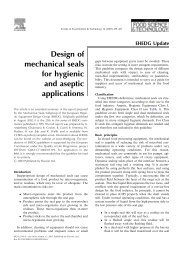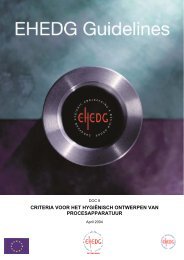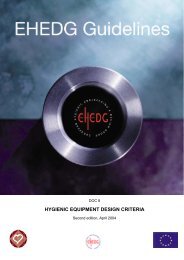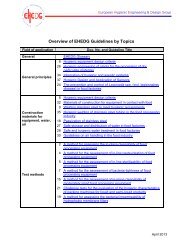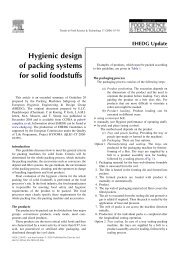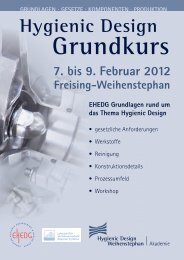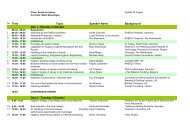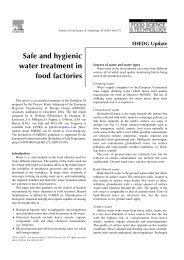Yearbook 2013/2014 - ehedg
Yearbook 2013/2014 - ehedg
Yearbook 2013/2014 - ehedg
Create successful ePaper yourself
Turn your PDF publications into a flip-book with our unique Google optimized e-Paper software.
160 EHEDG Guidelines<br />
Doc. 33. Hygienic engineering of<br />
discharging systems for dry particulate<br />
materials<br />
First edition, September 2005 (16 pages)<br />
The introduction of the product into the processing system<br />
is a key step in maintaining the sanitation and integrity of<br />
the entire process. Discharging systems are designed to<br />
transfer, in this case dry solids, from one system into another<br />
without powder spillage, contamination or environmental<br />
pollution. Many dry systems do not have any additional<br />
protective heating steps, as they are merely specialty<br />
blending processes. Therefore, any contamination that<br />
enters the system will appear in the finished product.<br />
Guidelines for the design of bag, big bag, container and<br />
truck discharging systems are presented. They are intended<br />
for use by persons involved in the design, sizing, and<br />
installation of bag, big bag and truck discharging systems<br />
operating under hygienic conditions.<br />
Languages available:<br />
Dutch, English, Spanish<br />
Doc. 34. Integration of hygienic and<br />
aseptic systems<br />
First edition, March 2006 (45 pages)<br />
Hygienic and/or aseptic systems comprise inter alia<br />
individual components, machinery, measurement systems,<br />
management systems and automation that are used to<br />
produce for example food products, medicines, cosmetics,<br />
home & personal products and even water products.<br />
This horizontal guideline is about the hygienically safe<br />
integration of hygienic (including aseptic) systems in a food<br />
production/ processing facility.<br />
Systems and components are frequently put together in a<br />
way that creates new hazards, especially microbiological<br />
ones. Deficiencies during the sequence of design,<br />
contract, design-change, fabrication, installation and<br />
commissioning are often the cause of these failures,<br />
even when specific design guidelines are available and<br />
are thought to be well understood. Errors in sequencing<br />
and content can also result in major penalties in terms<br />
of delays and in costs of components and construction.<br />
This document examines integration aspects that can<br />
affect hygienic design, installation, operation, automation,<br />
cleaning and maintenance and uses system flow charts<br />
and case studies describing the integration processes and<br />
decision steps. It does not provide detailed guidance on<br />
specific manufacturing processes, products, buildings or<br />
equipment.<br />
Training DVD available.<br />
Languages available: Armenian, English, Italian,<br />
Macedonian<br />
Doc. 35 Welding of stainless steel tubing<br />
in the food industry<br />
First edition, July 2006 (29 pages) - update in progress<br />
since 2010 in conjunction with Doc. 9<br />
Abundantly illustrated, this paper provides guidelines for<br />
the correct execution of on-axis hygienic (sanitary) welding<br />
between pipe segments, or between a tube and a control<br />
component (e.g. valve, flow meter, instrument tee, etc.) It<br />
deals with tube and pipe systems with less than 3.5 mm wall<br />
thickness, built in AISI 304(L) (1.4301, 1.4306 or 1.4307),<br />
316(L) (1.4401, 1.4404 or 1.4435), 316Ti (1.4571) or 904L<br />
(1.4539) and their equivalents. The requirements for a<br />
weld destined for hygienic uses are first described, then<br />
the possible defects which can affect the weld are listed,<br />
and at the end the procedure for a state-of-the-art welding<br />
execution is illustrated, including preparation of pipe ends,<br />
final inspection and a trouble shooting guide.<br />
It mainly refers to the part of the weld in contact with the<br />
finished or intermediate product and the only welding method<br />
considered is the GTAW (Gas Tungsten Arc Welding,<br />
commonly known as TIG) without filler material (autogenous<br />
weld), since this technique is capable of assuring the best<br />
performance in the execution of welds for the fabrication of<br />
thin wall stainless steel tubing. Inspection of welds will be<br />
covered in more detail in the next project.<br />
Training DVD available.<br />
Languages available: Dutch, English, French,<br />
German, Macedonian, Spanish<br />
Doc. 36. Hygienic engineering of transfer<br />
systems for dry particulate materials<br />
First edition, June 2007 (21 pages)<br />
Transfer (also known as transport or conveying) of dry<br />
particulate materials (products) between or within plant<br />
components in a process line is well practiced in the food<br />
industry. The transfer operation must be carried out in<br />
a hygienic and safe manner and the physical powder<br />
properties must not be affected during this operation. In this<br />
document, hygienic transfer systems for transport of bulk<br />
materials within a food processing plant are described. This<br />
document also covers situations where transfer systems are<br />
used as a dosing procedure.<br />
In principle, the less the need for product transfer within<br />
a food processing plant, the easier it is to make a factory<br />
hygienically safe. Furthermore, with a minimum of product<br />
transfer between equipment, there are the added advantages<br />
of a more compact plant, lower energy consumption and<br />
reduced cleaning time. Less product handling results in less<br />
adverse effects on product properties.<br />
This guideline is intended for use by persons involved in<br />
the design, technical specification, installation and use of<br />
transfer systems for dry bulk particulate materials operating<br />
under hygienic conditions.<br />
Languages available:<br />
Dutch, English, French, Macedonian



